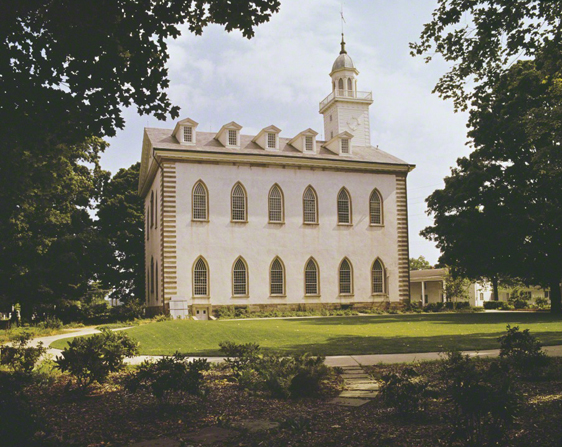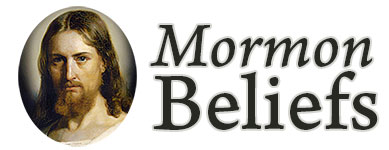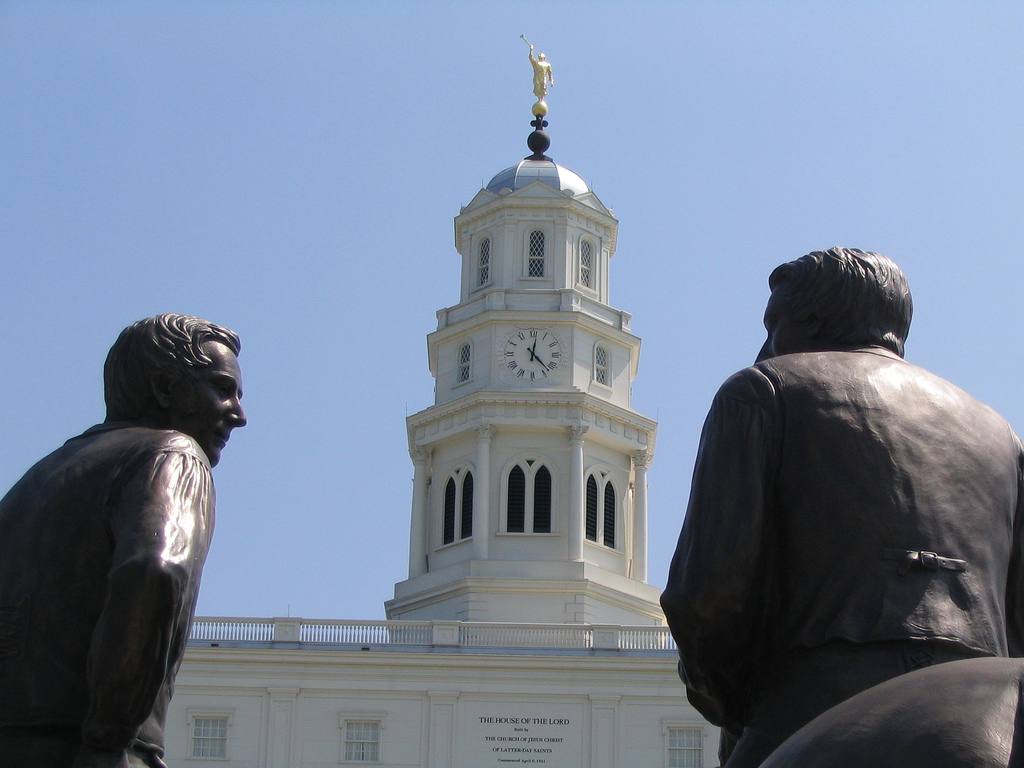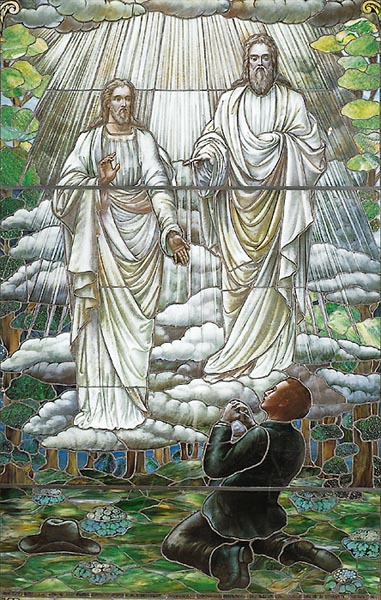The Importance of Temples and Prophets
Living prophets and temples of God are two hallmarks of the true Church of Jesus Christ in every dispensation, or period of time when the Lord reveals His gospel doctrines, ordinances and priesthood. The Church of Jesus Christ of Latter-day Saints teaches:
Throughout human history, God and Jesus Christ have made their true Church available whenever and wherever people have been willing to receive its blessings. He does this by following a consistent pattern.
The pattern begins when God, our Heavenly Father, calls a prophet to lead and teach the people (see Amos 3:7). From God, the prophet receives priesthood keys, which are the power and authority to direct the work of God on earth. This work includes ordinances (or religious ceremonies) necessary for salvation, such as being baptized and receiving the Holy Ghost (see John 3:5). The prophet also receives continuing revelation, or communication from God, regarding His will for the people. Under the authority and direction of the prophet, the people are organized into a church, where they can be taught God’s truths and receive ordinances.
The ordinances of the temple are the crowning blessings for members of The Church of Jesus Christ. The restoration of the temple blessings—as well as all of the other teachings of the gospel—began when the Lord called a prophet.
God Calls a Living Prophet
When the time came for Jesus Christ to restore His gospel in modern days, He began by calling a prophet. Or rather, by preparing a prophet. Joseph Smith’s calling and preparation began at the age of 14, when he knelt down in a grove of trees and prayed to know which church he should join. Elder Robert D. Hales explained:
In answer to Joseph’s prayer, God the Father and His Son, Jesus Christ, appeared to him. This humble farm boy was the prophet chosen by God to restore the ancient Church of Jesus Christ and His priesthood in these latter days. This restoration was to be the last, the dispensation of the fulness of times, restoring all the priesthood blessings which man could possess on earth. With this divine commission, his work was not to reform nor was it to protest what was already on the earth. It was to restore what had been on earth and had been lost.
With Joseph Smith’s divine commission, the Lord once again had a prophet on the earth. A prophet is, first and foremost, a witness of God and His mouthpiece on the earth. Elder A. Theodore Tuttle explained:
A prophet … is the authorized representative of the Lord. While the world may not recognize him, the important requirement is that God speaks through him. A prophet is a teacher. He receives revelations from the Lord. These may be new truths or explanations of truths already received.
Perhaps the most distinguishing characteristic of a prophet is that he does not choose his office. Elder Tuttle said:
A prophet need not have advanced educational degrees nor come from any special social class. He may be rich or poor. He needs no credentials from men.
What is it, then, that qualifies a man to be a prophet? Foremost, God must choose him as his prophet! This is entirely different than for man to choose God. The Savior, speaking to his apostles, said, “Ye have not chosen me, but I have chosen you, and ordained you, that ye should go and bring forth fruit…” (John 15:16).
The task of a living prophet is not an easy one. Elder Tuttle said:
It is an easy thing to believe in the dead prophets. Many people do. For some mysterious reason there is an aura of credibility about them. It is not so with the prophet who lives among us, who must meet life’s everyday challenges. But it is a great thing to believe in the living prophets. Our salvation is contingent upon our belief in a living prophet and adherence to his word. He alone has the right to revelation for the whole Church. His words, above those of any other man, ought to be esteemed and considered by the Church as well as by the world.
Joseph Smith’s prophetic call began the work of the Lord in the modern days.
The Prophet Receives Priesthood Keys
Joseph Smith’s task as the founding prophet of this dispensation was to restore the truths of the gospel of Jesus Christ that had been lost through the ages and to organize the modern Church of Jesus Christ in these last days. Elder Hales said:
The Restoration, begun with the First Vision in 1820, continued with the coming forth of the Book of Mormon: Another Testament of Jesus Christ. … Recorded on plates of gold, the Book of Mormon gives an account of Christ’s ministry in the Western Hemisphere, just as the Bible records His life and ministry in the Holy Land. Joseph received the gold plates … in December of 1827 [and] began to translate the Book of Mormon.
While translating, Joseph Smith and his scribe Oliver Cowdery read about baptism. Their desire to receive this blessing for themselves prompted the restoration of the Aaronic Priesthood on May 15, 1829, under the hands of John the Baptist.
There followed the restoration of the Melchizedek Priesthood, which was bestowed on Joseph and Oliver by the Apostles Peter, James, and John, who held the keys. After centuries of spiritual darkness, the power and authority to act in God’s name, to perform sacred ordinances, and to lead His Church were once again upon the earth.
With these sacred priesthood keys, the Lord was ready to establish The Church of Jesus Christ of Latter-day Saints through the Prophet Joseph Smith. This was done on April 6, 1830. However, there was more work to do and more priesthood keys to restore. But this work required the building of temples.
The Lord’s People Build a Temple

The Kirtland Temple in Kirtland, Ohio, was the first modern temple built by The Church of Jesus Christ of Latter-day Saints.
Throughout the ages, God has commanded His people to build temples. Elder Bruce R. McConkie explained:
The inspired erection and proper use of temples is one of the great evidences of the divinity of the Lord’s work. … Where there are temples, with the spirit of revelation resting upon those who administer therein, there the Lord’s people will be found; where these are not, the Church and kingdom and the truth of heaven are not (Mormon Doctrine, 2d ed., Salt Lake City: Bookcraft, 1966, p. 781).
The Lord needed a temple in which to restore the remaining keys of the kingdom of God and the crowning ordinances of the gospel. Elder Adney Y. Komatsu said:
Soon after the Church was organized on April 6, 1830, the Lord commanded the Saints to build a temple; and from 1833 to 1836, with fewer than two thousand members in the Church, the Prophet Joseph Smith and the Saints commenced to build a temple in Kirtland, Ohio.
The Saints at that time did not have many worldly possessions, but with great personal sacrifice they gave all they had to build the house of the Lord. Their sacrifices were many, but compared with the great blessing that followed, they were only small offerings unto the Lord.
And, indeed, the Saints received glorious blessings in Kirtland, Ohio. Elder Hales said:
The Kirtland Temple was the first temple in these latter days, and it played an important role in the restoration of priesthood keys. Joseph Smith, as a result of a prayer, was visited by Jesus in the Kirtland Temple on April 3, 1836 (see Doctrine & Covenants 110). The Savior appeared in glory and accepted the Kirtland Temple as His house. On that occasion Moses, Elias, and Elijah also appeared in order to commit the priesthood keys they held. Elijah restored the keys of the sealing power, as promised by Malachi, so that we could enjoy the fulness of the blessings of the temple in our lives.
With these blessings, the foundation of the spiritual kingdom of God was completed and the work could move forward. Mormon scholar Keith W. Perkins explained:
Without the keys restored in the Kirtland Temple, the Latter-day Saints would not have authority to perform the ordinances in their many temples. Washings and anointings had been given in January 1836. After attending to the washing of feet, Joseph assured the quorums that he “had given them all the instruction they needed” to go forth and build up the kingdom of God, having “passed through all the necessary ceremonies” (Teachings of the Prophet Joseph Smith, p. 110).
However, the ordinances performed in the Kirtland Temple were only a partial endowment, preparing the Latter-day Saints for the time that they would receive the full endowment.
Latter-day Saints Receive the Crowning Blessings of the Temple

The Prophet Joseph directed the building of the Nauvoo Temple, but did not live to see it completed.
The Kirtland Temple was only in operation for a short time before the Latter-day Saints were forced to leave their homes and abandon their temple. But they established a new city in Nauvoo, Illinois, and began again to build a temple. It was here that the fullness of the temple blessings were made available to those who were worthy and willing to receive them. Elder Hales said:
Our pioneer ancestors completed the Nauvoo Temple and performed sacred ordinances therein. The Nauvoo Temple was the first temple in which endowments and sealings were performed, which proved a great strength to the pioneers as they endured the hardships crossing the plains to Zion in the Salt Lake Valley. They had been endowed with power in the holy temple. Husband and wife were sealed to each other. Children were sealed to their parents. Many of them lost family members to death along the way, but they knew that wasn’t the end for them. They had been sealed in the temple for all eternity.
The blessings of the holy temple are available to both the living and the dead. President Boyd K. Packer taught:
In the temples, members of the Church who make themselves eligible can participate in the most exalted of the redeeming ordinances that have been revealed to mankind. There, in a sacred ceremony, an individual may be washed and anointed and instructed and endowed and sealed. And when we have received these blessings for ourselves, we may officiate for those who have died without having had the same opportunity. In the temples sacred ordinances are performed for the living and for the dead alike.
At last, the fullness of the gospel was restored to the earth and the crowning blessings of heaven were available to all who would partake. Through the Prophet Joseph, all of the priesthood keys and saving ordinances were returned to the earth. But the work of God did not end with his death. Mormon scholars Ralph and Todd Britsch explained:
An unbroken series of prophets have led the Church since the death of Joseph Smith in 1844…. Since 1847, these prophets have administered the affairs of the Church from Church headquarters in Salt Lake City. They have dedicated themselves to their appointed mission of helping the people of the world prepare for eternal life, and for the second coming of Jesus Christ. They have provided leadership for the international missionary program of the Church and for the building of temples. The living prophet continues to receive revelations, select and ordain leaders by the spirit of prophecy, and serve as the principal teacher of the Church, instructing its members in doctrine and in righteous living.
President Thomas S. Monson is the living prophet of The Church of Jesus Christ today. He is the sixteenth in an unbroken line of succession that began with the Prophet Joseph Smith. Prophets teach us the path that leads to eternal life—a path that leads to the temples of God.
Temple ordinances are the crowning blessings for Latter-day Saints because they bind families together and help us progress on our path to return to our Father in Heaven. The living prophet directs the work of the Lord on the earth, and in the temples sacred, saving ordinances are performed for both the living and the dead. Both are evidence that the living Lord is directing His living Church on the earth today.
Apostles of God: Dedicated Servants of the Lord
The First Presidency and the Quorum of the Twelve Apostles are dedicated servants of the Lord, and their spiritual seasoning is a blessing in their work.
Apostles, Prophets and LDS Church Organization
LDS Church organization is the same organization today that Christ established 2000 years ago, with prophets and apostles. Read on to learn more!
Living Prophets
God has always called prophets in the past. The Mormon Church believes in living prophets today who speak with authority from God on the earth. Read on!
Mormon Temples
Mormon temple ordinances are the crowning blessings available for members of The Church of Jesus Christ of Latter-day Saints. Find out why here.


